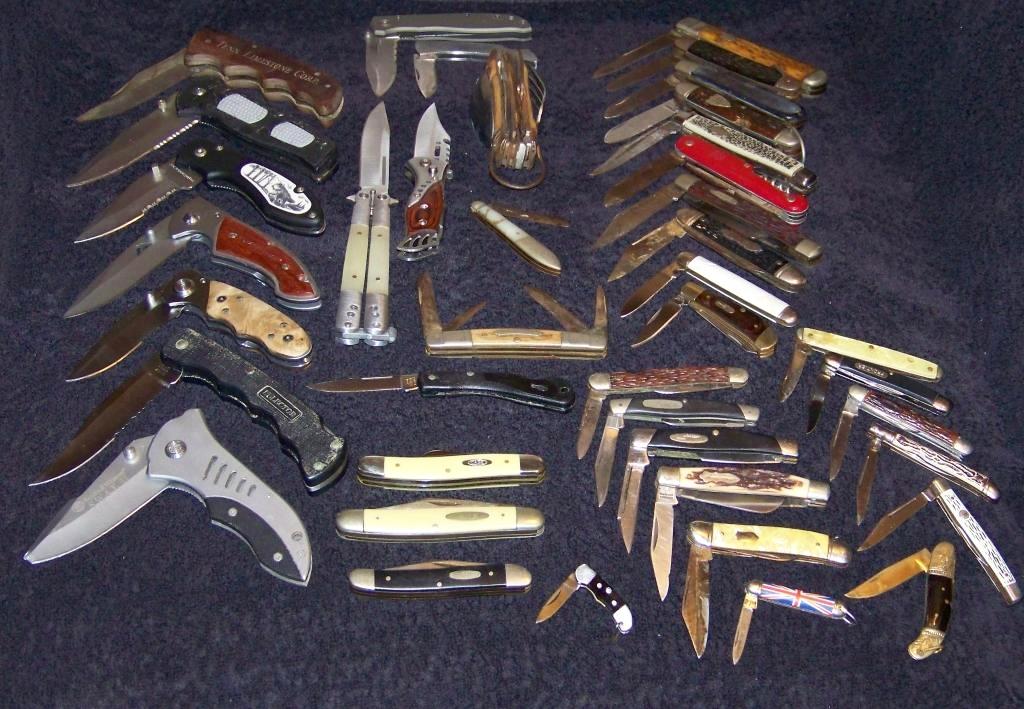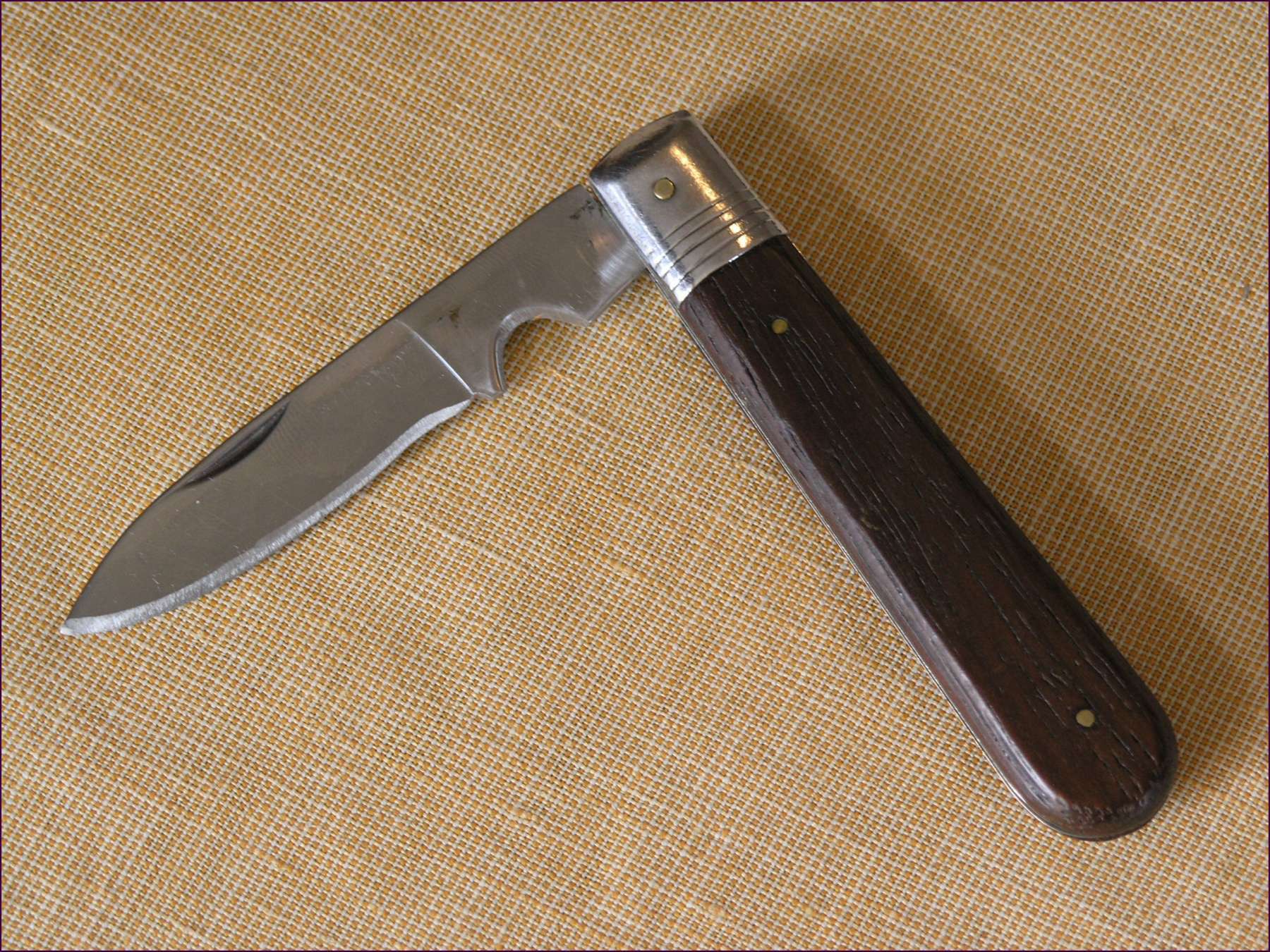|
Pocketknife
A pocketknife (also spelled as pocket knife) is a knife with one or more blades that fold into the handle. They are also known as jackknives, folding knives, Everyday carry, EDC knife, or may be referred to as a penknife, though a penknife may also be a specific kind of pocketknife. A typical blade length is . Pocketknives are versatile tools, and may be used for anything from whittling and Wood carving, woodcarving, to butchering Game (hunting), small game, gutting and filleting small fish, aiding in the preparation of tinder and kindling for fires, boring holes in soft material, to opening an envelope, cutting twine, slicing fruits and vegetables or as a means of self-defense. Pocketknives may also be used in conjunction with other tools and equipment for woodcraft and bushcraft. Specialised designs are also used for mushroom hunting and gardening. Pocketknives designed for gardening include pruning knives, which are folding knives with long curved blades used for pruning, t ... [...More Info...] [...Related Items...] OR: [Wikipedia] [Google] [Baidu] |
Knife
A knife (: knives; from Old Norse 'knife, dirk') is a tool or weapon with a cutting edge or blade, usually attached to a handle or hilt. One of the earliest tools used by humanity, knives appeared at least Stone Age, 2.5 million years ago, as evidenced by the Oldowan tools. Originally made of wood, bone, and stone (such as flint and obsidian), over the centuries, in step with improvements in both metallurgy and manufacturing, knife blades have been made from copper, bronze, iron, steel, ceramic, and titanium. Most modern knives have either fixed or folding blades; blade patterns and styles vary by maker and country of origin. Knives can serve various purposes. Hunters use a hunting knife, soldiers use the combat knife, scouts, campers, and hiking, hikers carry a pocketknife; there are kitchen knives for preparing foods (the chef's knife, the paring knife, bread knife, cleaver), table knife (butter knives and steak knives), weapons (daggers or switchblades), knives for throwing o ... [...More Info...] [...Related Items...] OR: [Wikipedia] [Google] [Baidu] |
Penknife
Penknife, or pen knife, is a small folding knife. Today ''penknife'' is also the common British English term for both a pocketknife, which can have single or multiple blades, and for multi-tools, with additional tools incorporated into the design. History Originally, penknives were used for thinning and pointing quills (cf. ''penna'', Latin for ''feather'') to prepare them for use as dip pens and, later, for repairing or re-pointing the Nib (pen), nib. A penknife might also be used to sharpen a pencil, prior to the invention of the pencil sharpener. In the mid-1800s, penknives were necessary to slice the uncut edges of newspapers and books. A penknife did not necessarily have a folding blade, but might resemble a scalpel or chisel by having a short, fixed blade at the end of a long handle. During the 20th century there has been a proliferation of multi-function pocketknives with assorted blades and gadgets, the most famous of which is the Swiss Army knife, referred to in Brit ... [...More Info...] [...Related Items...] OR: [Wikipedia] [Google] [Baidu] |
Penny Knife
The penny knife was a originally a simple 18th century utility knife with a fixed blade. It got the name ''penny knife'' because it cost 1 penny in England and the United States towards the end of the 18th century. The famous ''Fuller's Penny Knife'' helped gain the reputation of Sheffield, England cutlers in the pre-industrial era of the early 18th century. Description The ''penny knife'' later evolved into a basic, mass-produced pocketknife with a folding blade, which pivoted freely in and out of the handle without a backspring or other device to hold it in position (other than the frictional pressures of the knife handle). This type of knife was popular with farmers in the United States, England, France, Italy, Portugal, and Spain for much of the 19th and part of the 20th century, and consequently is often called a ''farmer knife'', ''sodbuster knife'', or ''peasant knife''.''The Youth's Companion'', Boston, MA: Perry Mason & Co., Vol. 52, No. 1 (2 January 1879), p. 108 Ant ... [...More Info...] [...Related Items...] OR: [Wikipedia] [Google] [Baidu] |
Grafting
Grafting or graftage is a horticulture, horticultural technique whereby tissues of plants are joined so as to continue their growth together. The upper part of the combined plant is called the scion () while the lower part is called the rootstock. The success of this joining requires that the vascular tissues grow together. The natural equivalent of this process is inosculation. The technique is most commonly used in asexual reproduction, asexual plant propagation, propagation of commercially grown plants for the horticultural and agricultural trades. The scion is typically joined to the rootstock at the soil line; however, top work grafting may occur far above this line, leaving an understock consisting of the lower part of the trunk and the root system. In most cases, the stock or rootstock is selected for its roots and the scion is selected for its Plant stem, stems, Leaf, leaves, flowers, or fruits. The scion contains the desired genes to be duplicated in future production ... [...More Info...] [...Related Items...] OR: [Wikipedia] [Google] [Baidu] |
Bolster (knife)
A kitchen knife is any knife that is intended to be used in food preparation. While much of this work can be accomplished with a few general-purpose knives — notably a large chef's knife and a smaller serrated blade utility knife — there are also many specialized knives that are designed for specific tasks such as a tough cleaver, a small paring knife, and a bread knife. Kitchen knives can be made from several different materials, though the most common is a hardened steel blade with a wooden handle. Historically, knives were made in "knife cities" that are noted for being the best at their production in that country with the pre-emininent, in Europe, being: Sheffield in Yorkshire, North of England; Thiers, Puy-de-Dôme in the Auvergne of France; Solingen in the Northern Rhineland of Germany; and Eskilstuna of Södermanland County in Sweden. Each of these produced knives in a styles particular to the city, with Thiers especially being noted for the French point of Laguiole ... [...More Info...] [...Related Items...] OR: [Wikipedia] [Google] [Baidu] |
Industrial Revolution
The Industrial Revolution, sometimes divided into the First Industrial Revolution and Second Industrial Revolution, was a transitional period of the global economy toward more widespread, efficient and stable manufacturing processes, succeeding the Second Agricultural Revolution. Beginning in Kingdom of Great Britain, Great Britain around 1760, the Industrial Revolution had spread to continental Europe and the United States by about 1840. This transition included going from craft production, hand production methods to machines; new Chemical industry, chemical manufacturing and Puddling (metallurgy), iron production processes; the increasing use of Hydropower, water power and Steam engine, steam power; the development of machine tools; and rise of the mechanisation, mechanised factory system. Output greatly increased, and the result was an unprecedented rise in population and population growth. The textile industry was the first to use modern production methods, and textiles b ... [...More Info...] [...Related Items...] OR: [Wikipedia] [Google] [Baidu] |
Spring (device)
A spring is a device consisting of an Elasticity (physics), elastic but largely rigid material (typically metal) bent or molded into a form (especially a coil) that can return into shape after being compressed or extended. Springs can Energy storage, store energy when compressed. In everyday use, the term most often refers to coil springs, but there are many different spring designs. Modern springs are typically manufactured from spring steel. An example of a non-metallic spring is the Bow (weapon), bow, made traditionally of flexible Taxus baccata, yew wood, which when Bow draw, drawn stores energy to propel an arrow. When a conventional spring, without stiffness variability features, is compressed or stretched from its resting position, it exerts an opposing force approximately proportional to its change in length (this approximation breaks down for larger deflections). The ''rate'' or ''spring constant'' of a spring is the change in the force it exerts, divided by the cha ... [...More Info...] [...Related Items...] OR: [Wikipedia] [Google] [Baidu] |
Opinel
Opinel is a French manufacturer of pocket knives. The company has made its line of eponymous wooden-handled knife, knives since 1890 from its headquarters in Saint-Jean-de-Maurienne, Savoie. The company sells approximately 15 million knives annually. Opinel knives are made of both high carbon and stainless steel, the latter being Sandvik steel from Sweden. Originally sold as a working man's knife, an Opinel knife has become emblematic of French culture.C NEWS, Le Couteau Opinel, La Lame Universelle', Directsoir, no 233, 30 october 2007, republished 7 July 2013, retrieved 15 May 2022 Pablo Picasso is said to have used one of the company's knives as a sculpting tool. In 1989, the Petit Larousse, Larousse dictionary cited "Opinel" as a registered trademark. History Joseph Opinel began making knives in 1890 in Savoie, France as a simple working man's or ''Penny knife, peasant's knife''.''L'Opinel, une fine lame toujours à l'affût'', Rhône-Alpes, April 2006, retrieved 15 May 2022 ... [...More Info...] [...Related Items...] OR: [Wikipedia] [Google] [Baidu] |
Sheffield, England
Sheffield is a city in South Yorkshire, England, situated south of Leeds and east of Manchester. The city is the administrative centre of the City of Sheffield. It is historically part of the West Riding of Yorkshire and some of its southern suburbs were transferred from Derbyshire to the city council. It is the largest settlement in South Yorkshire and the third largest of Northern England. The city is in the North Midlands, in the eastern foothills of the Pennines and the valleys of the River Don with its four tributaries: the Loxley, the Porter Brook, the Rivelin and the Sheaf. Sixty-one per cent of Sheffield's entire area is green space and a third of the city lies within the Peak District national park and is the fifth-largest city in England. There are more than 250 parks, woodlands and gardens in the city, which is estimated to contain around 4.5 million trees. Sheffield played a crucial role in the Industrial Revolution, developing many significant techn ... [...More Info...] [...Related Items...] OR: [Wikipedia] [Google] [Baidu] |
Viking Age
The Viking Age (about ) was the period during the Middle Ages when Norsemen known as Vikings undertook large-scale raiding, colonising, conquest, and trading throughout Europe and reached North America. The Viking Age applies not only to their homeland of Scandinavia but also to any place significantly settled by North Germanic peoples, Scandinavians during the period. Although few of the Scandinavians of the Viking Age were Vikings in the sense of being engaged in piracy, they are often referred to as ''Vikings'' as well as ''Norsemen''. Voyaging by sea from their homelands in Denmark, Norway, and Sweden, the Norse people settled in the Viking activity in the British Isles, British Isles, History of Ireland (800–1169), Ireland, the Faroe Islands, Settlement of Iceland, Iceland, Norse settlements in Greenland, Greenland, History of Normandy, Normandy, and the Baltic Sea, Baltic coast and along the Trade route from the Varangians to the Greeks, Dnieper and Volga trade rout ... [...More Info...] [...Related Items...] OR: [Wikipedia] [Google] [Baidu] |








